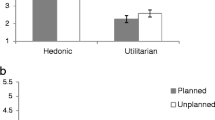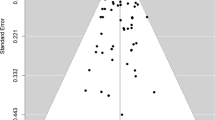Abstract
Purchase intention and willingness-to-pay (WTP) questions are often analyzed without considering that a respondent's utility maximizing answer need not correspond to a truthful answer. In this paper, we argue that individuals act, at least partially, in their own self-interest when answering survey questions. Consumers are conceptualized as thinking along two strategic dimensions when asked hypothetical purchase intention and WTP questions: (a) whether their response will influence the future price of a product and (b) whether their response will influence whether a product will actually be offered. Results provide initial evidence that strategic behavior may exist for some goods and some people.

Similar content being viewed by others
References
Bemmaor, A. C. (1995). Predicting behavior from intention-to-buy measures: The parametric case. Journal of Marketing Research, 32, 176–192.
Carson, R., Flores, N. E., & Meade, N. F. (2001). Contingent valuation: Controversies and evidence. Environmental and Resource Economics, 19, 173–210.
Chardon, P., Morwitz, V. G., & Reinartz, W. J. (2005). Do intentions really predict behavior? Self-generated validity effects in survey research. Journal of Marketing, 69, 1–14.
Crowne, D. P., & Marlowe, D. (1964). The approval motive: Studies in evaluative dependence. New York: Wiley.
Cummings, R. G., & Taylor, L. O. (1999). Unbiased value estimates for environmental goods: A cheap talk design for the contingent valuation method. American Economic Review, 89, 649–665.
Ding, M., Grewal, R., & Liechty, J. (2005). Incentive-aligned conjoint analysis. Journal of Marketing Research, 42, 67–83.
Fishbein, M., & Ajzen, I. (1975). Belief, attitude, intention and behavior. Reading, MA: Addison-Wesley.
Fisher, R. J. (1993). Social desirability bias and the validity of indirect questioning. Journal of Consumer Research, 20, 303–326.
Gibson, L. D. (2001). What's wrong with conjoint analysis? Marketing Research, 16–19.
Greenleaf, E. A. (1992). Improving rating scale measures by detecting and correcting bias components in some response styles. Journal of Marketing Research, 29, 176–189.
Hoffman, E., Menkhaus, D., Chakravarti, D., Field, R., & Whipple, G. (1993). Using laboratory experimental auctions in marketing research: A case study of new packaging for fresh beef. Marketing Science, 12, 318–338.
Jamieson, L., & Bass, F. (1989). Adjusting stated intention measures to predict trial of new products: A comparison of models and methods. Journal of Marketing Research, 26, 336–345.
Jedidi, K., Jagpal, S., & Manchanda, P. (2003). Measuring heterogeneous reservation prices for product bundles. Marketing Science, 22, 107–130.
Laurent, G., & Kapferer, J. N. (1985). Measuring consumer involvement profiles. Journal of Marketing Research, 22, 41–53.
Loewenstein, G., & Adler, D. (1995). A bias in predictions of tastes. The Economic Journal, 105, 929–937.
Lusk, J. L., & Schroeder, T. C. (2004). Are choice experiments incentive compatible? A test with quality differentiated beef steaks. American Journal of Agricultural Economics, 86, 467–482.
Lusk, J. L., & Shogren, J. F. (in press). Experimental auctions: Methods and applications in economic and marketing research. Cambridge, UK: Cambridge University Press.
Manski, C. F. (1990). The use of intentions data to predict behavior: A best-case analysis. Journal of the American Statistical Association, 85, 934–940.
Mittal, V., & Kamakura, W. A. (2001). Satisfaction, repurchase intent, and repurchase behavior: Investigating the moderating effect of customer characteristics. Journal of Marketing Research, 38, 131–142.
Mittal, B., & Lee, M. (1989). A causal model of consumer involvement. Journal of Economic Psychology, 10, 363–389.
Monroe, K. K. (1990). Pricing: Making profitable decisions. New York: McGraw-Hill.
Morrison, D. G. (1979). Purchase intentions and purchase behavior. Journal of Marketing, 43, 65–74.
Morwitz, V. G. (1997). Why consumers don't always accurately predict their own future behavior. Marketing Letters, 8, 57–70.
Morwitz, V. G. (2001). Methods for forecasting from intentions data. In J. S. Armstrong (Ed.), Principles of forecasting: A handbook for researchers and practitioners (pp. 34–56). Norwell, MA: Kluwer Academic.
Ones, D. S., Viswesvaran, C., & Schmidt, F. L. (1993). Meta-analysis of integrity test validities: Findings and implications for personnel selection and theories of job performance. Journal of Applied Psychology, 78, 679–703.
Sherif, M., & Cantril, H. (1947). The psychology of ego involvement. New York: Wiley.
Sun, B., & Morwitz, V. G. (2005). Predicting purchase behavior from stated intentions: A unified model. Working paper, Department of Marketing, Carnegie Mellon University.
Urban, G. L., Hatch, G. E., & Silk, A. J. (1983). The ASSESSOR pre-test market evaluation system. Interfaces, 13, 38–59.
Wertenbroch, K., & Skiera, B. (2002). Measuring consumers' willingness to pay at the point of purchase. Journal of Marketing Research, 39, 228–241.
Zaichkowsky, J. L. (1985). Measuring the involvement construct. Journal of Consumer Research, 12, 341–351.
Zaichkowsky, J. L. (1994). The personal involvement inventory: Reduction, revision, and application to advertising. Journal of Advertising, 23, 59–71.
Author information
Authors and Affiliations
Corresponding author
Rights and permissions
About this article
Cite this article
Lusk, J.L., McLaughlin, L. & Jaeger, S.R. Strategy and response to purchase intention questions. Market Lett 18, 31–44 (2007). https://doi.org/10.1007/s11002-006-9005-7
Received:
Accepted:
Published:
Issue Date:
DOI: https://doi.org/10.1007/s11002-006-9005-7




